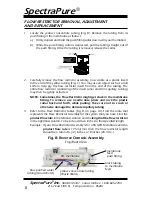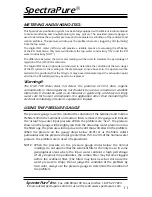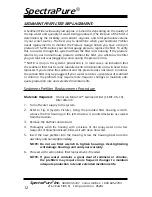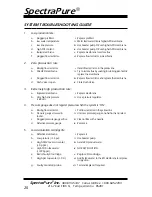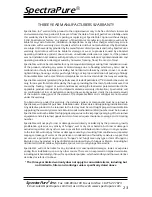
SpectraPure
®
SpectraPure
®
Inc.
480.894.5437 Call us toll-free 1.800.685.2783
2167 East Fifth St, Tempe, Arizona 85281
14
RO MEMBRANE DIAGNOSTIC:
Although RO membranes are capable of maintaining high water quality
over extended periods of time they eventually will begin to deteriorate.
Normally, the conductivity of the permeate water will increase as the
membranes age, and/or the production slows down as they plug up
with hardness. By comparing the difference in TDS readings between the
Tap water conductivity and the RO water conductivity, the percentage
of rejection of the RO membrane may be calculated and the resultant
may then be used to determine the condition of the membrane and the
operator will know when the membrane needs to be replaced. Membrane
failure can be indicated by a reduction of the percentage of rejection
which will be determined by calculating the differential between the input
and output TDS values.
In order to accurately determine the condition of the RO Membrane, a
conductivity (TDS) meter capable of reading the tap water conductivity
and the permeate (or product) water conductivity has been provided with
this system. With the assistance of the TDS meter you will be able to easily
determine the RO membrane’s condition.
Before performing the diagnostic test on the RO membrane, make
sure that the RO system has been “ON” and producing water for a
minimum of 10 minutes. Also check the brine (yellow) line to make sure
that water is flowing and that the flow ratio between the permeate water
and the brine water is at a ratio that is between 3 to 1 and 4 to 1.
NOTE: The pressure gauge should indicate a pressure reading of > 40 PSI
during this test period.
Procedure:
1.
Turn on the left meter by depressing the on switch.
2.
Locate the meter slide switch on the front of the TDS meter.
3.
Slide the switch to the Left “IN” position, read the Tap water conductivity
and record the reading ________ .
4.
Next, slide the switch the to Right “OUT” position, read the RO water
conductivity and record the reading ________.
5.
See page 15 on “TESTING THE RO MEMBRANE REJECTION RATE”.








